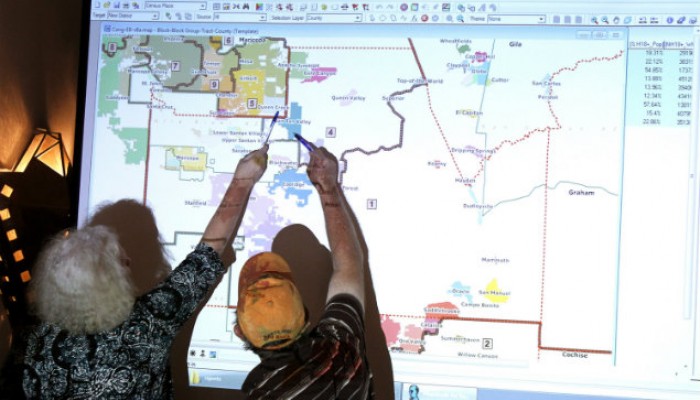In 2018, Americans across the country will go to the polls to vote for their congressional representatives. Most states will also elect their state legislature. The choices that voters have will depend on the district lines that were drawn in a process called redistricting.
Here’s what you need to know:
What is redistricting?
Members of Congress, state legislators, and many county and municipal offices are elected by voters grouped into districts. But populations change. Some districts gain residents, others lose them. Districts also may change demographically. That’s why district boundaries are redrawn every ten years to ensure each district has about the same number of people and that districts are reflective and representative of the electorate.
Who draws the lines?
Each state decides. In most states, the state legislature draws lines both for the legislature and for the state’s congressional delegation. Typically, the governor can veto a map.
To assist in the process, some states have special commissions that advise legislators on drawing the map, or that serve as backup mapmakers if the legislature deadlocks.
And a growing number of states have independent commissions where ordinary citizens rather than politicians draw districts.
Why does redistricting matter?
Redistricting affects political power. It determines which party controls Congress and state and local governments across the country. Consequently, redistricting has a direct bearing on what matters a legislature chooses to tackle, and which to ignore.
Redistricting also affects whether the nation’s diverse communities are represented in its legislative bodies. Redistricting, for example, can ensure that communities of color have a fair shot at electing candidates who represent their worldview and will fight for their concerns. Or it can exclude them from having a seat at the table. Ditto all other kinds of communities of interest.
How should the lines be drawn?
A good redistricting process should help a community secure meaningful representation. Many states consider “communities of interest” when drawing their districts and that’s a good place to start. Community of interest is a term for groups of people who share common social, cultural, racial, economic, geographic, or other concerns. These groups are likely to have similar legislative interests as well, and that means they can benefit from common representation in the government. This goes much deeper than Republican or Democrat. A district of farmers, say, and a district of city dwellers will probably elect representatives that reflect differing histories, priorities, and aspirations. Other redistricting goals — like keeping a district compact or within county borders — are usually proxies for keeping communities intact. A good redistricting process will be open and transparent, allowing communities to ask questions and give input. This participation is important, since communities are the basic units of well-designed districts.
What is gerrymandering?
Gerrymandering refers to the manipulation of district lines to protect or change political power.
In most states, the legislature is responsible for drawing electoral boundaries. But this process can go awry and result in gerrymandering. One political party, for example, may use its unilateral ability to pass a map to lock in a disproportionate share of seats. A different kind of gerrymandering also can take place when maps are drawn in a way that disadvantages racial or ethnic minorities.
Unfortunately, the United States is unique among developed democracies in leaving the power to draw maps, by and large, in the hands of interested politicians. As a result, it’s probably not surprising that maps still are not final in more than half a dozen states because of pending litigation over gerrymandering allegations.
How does gerrymandering affect democracy?
John Adams and the Framers of the Constitution thought that legislative bodies should be “an exact Portrait, a Miniature, of the People at large.” Redistricting allows districts to be rebalanced, ensuring to the greatest extent possible that all districts are both equally populated and representative.
Gerrymandering, on the other hand, distorts representation. In some states this decade, gerrymandered maps have allowed a political party to entrench its majority despite receiving a minority of the votes, and thus creating an environment in which the majority of voters may not see their preferred policies enacted. Gerrymandering affects what laws are created, which communities receive meaningful representation, and which party can win elections. An analysis of congressional districts drawn during the last redistricting cycle in 2011 found that the maps were consistently biased in favor of Republicans as a result of gerrymandering. This has resulted in Republicans having a 13 to 5 advantage in Pennsylvania’s congressional delegation despite the fact that the state is the quintessential battleground state. Similar distortions have been built into maps at the state and local level. Sometimes Republicans are to blame. In other cases, Democrats were the gerrymanderers. At the end of the day, it’s about more than political power. When district lines are drawn to favor or disadvantage a political party, meaningful representation is compromised and community interests are sacrificed to the partisan goals of political parties.
When is the next redistricting cycle, and what can you do now?
The next redistricting will be after the 2020 census. You can hold the line drawers accountable by paying attention and speaking up. Call your state legislators and tell them you want a fair redistricting process. Participate in community mapping exercises where citizens get together and jointly work on proposed solutions. Help change the process. Lawmakers and advocacy and grassroots organizations will propose redistricting reform measures in the next few years.
Revised July 3, 2017
(Photo: AP)



